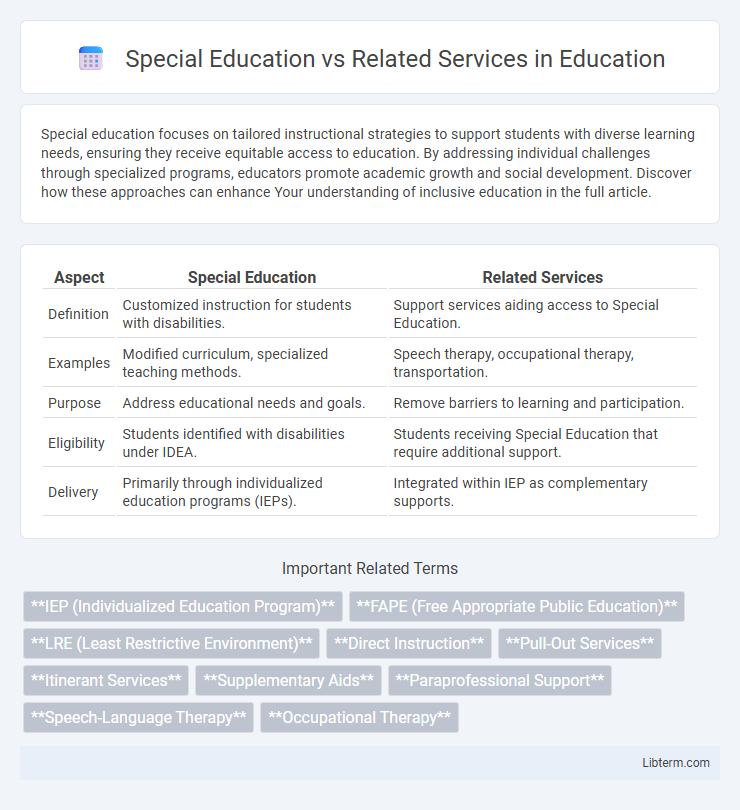Special education focuses on tailored instructional strategies to support students with diverse learning needs, ensuring they receive equitable access to education. By addressing individual challenges through specialized programs, educators promote academic growth and social development. Discover how these approaches can enhance Your understanding of inclusive education in the full article.
Table of Comparison
| Aspect | Special Education | Related Services |
|---|---|---|
| Definition | Customized instruction for students with disabilities. | Support services aiding access to Special Education. |
| Examples | Modified curriculum, specialized teaching methods. | Speech therapy, occupational therapy, transportation. |
| Purpose | Address educational needs and goals. | Remove barriers to learning and participation. |
| Eligibility | Students identified with disabilities under IDEA. | Students receiving Special Education that require additional support. |
| Delivery | Primarily through individualized education programs (IEPs). | Integrated within IEP as complementary supports. |
Understanding Special Education: A Comprehensive Overview
Special Education encompasses tailored instructional strategies designed to meet the unique needs of students with disabilities, ensuring access to a free appropriate public education (FAPE) under the Individuals with Disabilities Education Act (IDEA). Related Services include supportive services such as speech therapy, occupational therapy, and counseling that assist students in benefiting from their special education program. Understanding Special Education requires recognizing the role of both specialized instruction and related services in promoting academic achievement and functional performance for students with disabilities.
Defining Related Services in the Educational Context
Related services in the educational context refer to supplementary supports provided to students with disabilities to enable them to benefit from special education. These services include transportation, speech-language therapy, occupational therapy, physical therapy, counseling, and psychological services, among others, as outlined in the Individuals with Disabilities Education Act (IDEA). Unlike special education, which involves specialized instruction tailored to individual learning needs, related services focus on addressing functional and developmental needs to support academic achievement and effective participation in school activities.
Key Differences Between Special Education and Related Services
Special Education provides specialized instruction tailored to meet the unique needs of students with disabilities, focusing on academic, social, and life skills development. Related Services encompass supportive services such as speech therapy, occupational therapy, and counseling necessary for a child to benefit from special education. The key difference lies in Special Education being direct teaching, while Related Services are supplementary aids supporting the child's educational progress.
Legal Foundations: IDEA and Student Rights
The legal foundation for Special Education and Related Services is primarily established by the Individuals with Disabilities Education Act (IDEA), which guarantees students with disabilities the right to a Free Appropriate Public Education (FAPE) in the Least Restrictive Environment (LRE). Special Education refers to customized instructional programs designed to meet the unique needs of eligible students, while Related Services include supportive services such as speech therapy, occupational therapy, and counseling that enable students to benefit from Special Education. IDEA mandates individualized education plans (IEPs) to outline both Special Education and Related Services, ensuring student rights to access tailored educational opportunities and procedural safeguards.
Eligibility Criteria for Special Education and Related Services
Eligibility for Special Education under the Individuals with Disabilities Education Act (IDEA) requires a determination that a student has one or more of the 13 specified disabilities that adversely affect educational performance and necessitate specially designed instruction. Related Services eligibility hinges on the student's need for supportive services such as speech therapy, occupational therapy, or counseling, which enable access to and benefit from special education. Comprehensive evaluations by a multidisciplinary team assess the student's unique needs to establish qualification for both Special Education and Related Services.
Collaborative Roles: Teachers, Therapists, and Support Staff
Special education involves direct instruction tailored to students with disabilities, where teachers design individualized education programs (IEPs) to address learning needs, while related services include therapeutic support such as speech therapy, occupational therapy, and counseling provided by specialized therapists. Teachers, therapists, and support staff work collaboratively to implement IEP goals, share progress data, and adapt strategies to enhance student outcomes. This integrated team approach ensures comprehensive support, combining academic instruction with necessary health and developmental services to foster student success.
Examples of Special Education Programs and Related Services
Special education programs include tailored instruction such as resource rooms, inclusion classrooms, and self-contained classrooms designed to meet individual student needs under an Individualized Education Program (IEP). Related services encompass support services like speech therapy, occupational therapy, physical therapy, and counseling that enable students to benefit from special education. Together, these programs and services create a comprehensive approach to addressing diverse learning disabilities, speech impairments, physical challenges, and emotional disorders in the educational environment.
Impact on Student Outcomes: Academic and Social Development
Special education provides tailored instructional strategies and individualized learning plans that directly enhance academic performance and foster cognitive growth in students with disabilities. Related services, such as speech therapy, occupational therapy, and counseling, support social development by addressing communication, motor skills, and emotional well-being, crucial for meaningful classroom engagement. Combining specialized instruction with related services optimizes student outcomes by promoting both educational achievement and social integration.
Navigating the IEP Process: Integrating Services Effectively
Navigating the IEP process requires a clear understanding of how special education and related services work together to meet a student's unique needs. Special education provides tailored instruction, while related services such as speech therapy, occupational therapy, and counseling support the student's ability to benefit from that instruction. Effective integration of these services in the IEP ensures comprehensive support and maximizes educational outcomes for students with disabilities.
Empowering Families: Advocating for Student Needs
Special education provides tailored instructional support to students with disabilities, ensuring access to appropriate learning environments and individualized education programs (IEPs). Related services, such as speech therapy, occupational therapy, and counseling, complement these educational goals by addressing specific developmental needs. Empowering families through clear communication and informed advocacy strengthens collaboration with educators and professionals, leading to more effective interventions and positive student outcomes.
Special Education Infographic

 libterm.com
libterm.com